High radiators: features of cast iron, aluminum, bimetallic
Existing standards for heating devices do not limit the size of batteries. Therefore, recently, high heating radiators have appeared on the market, which have some advantages over standard appliances. Below we take a look at their features, types and basic parameters.
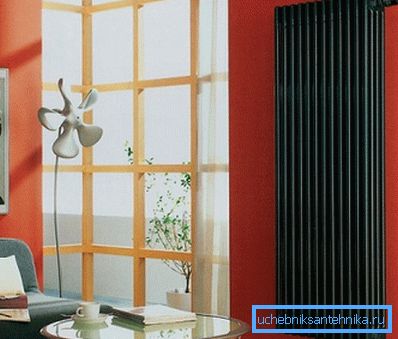
General information
Despite the absence of any strict framework limiting the size of heating devices, manufacturers of cast-iron batteries produce products of standard sizes and are in no hurry to please buyers with non-standard frame sizes of their products. Therefore, high (vertical) batteries appeared only when they began selling devices made of alternative materials - aluminum and steel.
This greatly expanded the possibilities of organizing individual heating systems. Moreover, high appliances not only create an effective heat curtain, but can also be used by designers to translate various interior design ideas.
The only thing to consider is that low radiators are more efficient because they heat the lower part of the room. This leads to intense air convection and more uniform heating of the space.
Types of high batteries
At present, high batteries, in fact, like standard-sized devices, differ primarily in the material from which they are made.
By this parameter, they are divided into:
- Cast iron;
- Aluminum;
- Bimetallic;
- Steel.
Below we take a closer look at their features.
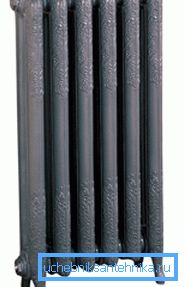
Cast iron
First of all, it should be said that cast-iron radiators of non-standard sizes are quite rare. The most common of these are devices from the Turkish manufacturer DEMRAD. This company abandoned the design of the last century and offered art casting to customers.
Due to this, cast iron radiators of their production serve not only as appliances for heating, but also as elements of interior decoration. As for the size, the highest batteries have the following parameters:
| Options | Value mm |
| Center distance | 800 |
| Depth | 203 |
| Height | 954 |

These dimensions are quite impressive - one section holds more than three liters of coolant.
This feature is associated with some drawbacks of the heater:
- As practice shows, it is impossible to drive such amount of liquid at a high speed. As a result, the device quickly becomes clogged during operation, and therefore needs regular cleaning.
- One section itself weighs over 13 kg. One can only imagine how much a radiator filled with coolant will weigh. Therefore, such devices are not designed for mounting on the wall; therefore, the manufacturer supplies them with legs.
- The devices are designed for a working pressure in the system of 10 atm. Therefore, they do not withstand hydraulic shocks, which are inherent in our centralized heating systems.
Tip! You can clean the radiators with your own hands with the help of special liquids that are poured into the system.
In addition, it should be noted that these devices have a relatively low heat transfer, which is associated with the peculiarity of the material itself. Therefore, their installation is usually dictated by design ideas, rather than practical considerations.
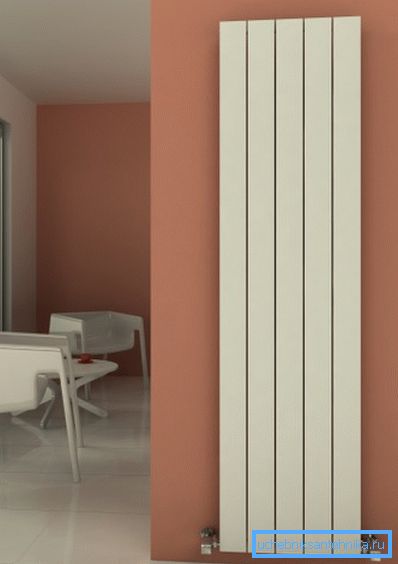
Aluminum
Limitations of radiator size in this case imposes only the height of the ceilings. The horizontal position provides compact dimensions. Therefore, most often they are installed in narrow corridors and rooms.
The most common among such radiators are Italian batteries from the company GLOBAL. They have the following parameters:
| Options | Value |
| Height | 2046 |
| Heat transfer | 433 W |
Aluminum radiators have many advantages:
- Have a small weight.
- Non-corrosive.
- Possess good heat dissipation.
However, they cannot be connected to centralized heating systems, as they are not designed for high pressure.
In addition, they have some other disadvantages:
- High price.
- The system must use a clean coolant, otherwise they will quickly become clogged.
Therefore, aluminum batteries are suitable for use only in private homes or apartments with autonomous heating systems. As for their installation, it is carried out using brackets or mounting strips, i.e. as well as the installation of radiators of conventional sizes.
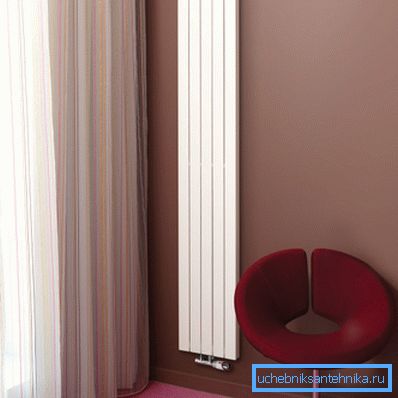
Bimetallic
High bimetallic heating radiators are in many respects similar to aluminum counterparts, however, they are more durable, making them suitable for use in centralized systems. Their peculiarity is that all the channels are made of steel, and the fins are made of aluminum.
Otherwise, they are similar to the above aluminum devices.
Note! Bimetallic radiators can be found on sale, both high and low. The latter are usually two times lower than traditional ones, but wider at the same time, which ensures their increased efficiency.

Steel
Steel design radiators are the most popular, due to the wide possibilities of artistic performance of these products. And on the market there are such devices, both foreign and domestic production.
As a rule, their height reaches two meters. Thick-walled tubes are used as a material for these batteries, which allows them to withstand pressures up to 25 atmospheres.
These products also weigh a little, compared to cast iron counterparts, and at the same time have the best heat transfer. For example, a device with a width of 490 mm and a height of two meters in terms of heat transfer corresponds to 14 standard sections of a cast iron radiator.
Note! The installation instructions for vertical radiators imply their location on the side of a window or on solid walls.
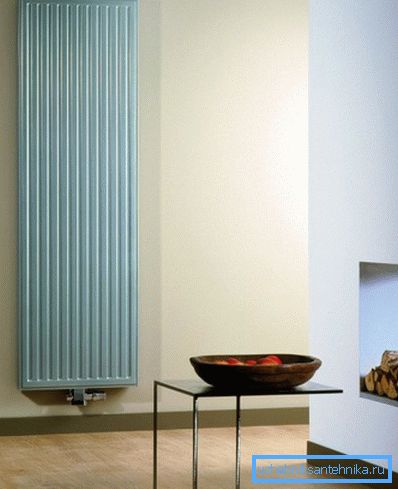
It should be noted that steel batteries can be not only tubular, but also panel. The latter are also quite durable and efficient, while cost less.
Here, perhaps, and all the main points that you should know when choosing a vertical battery.
Conclusion
High and narrow radiators have their own advantages and disadvantages, while the latter clearly benefit in terms of decoration. In addition, they are a practical solution for narrow rooms and corridors. However, when choosing, it is necessary to take into account the peculiarities of their various types, with which we have read above.
From the video in this article, you can get additional useful information on the topic voiced above.